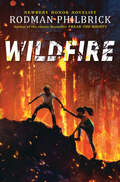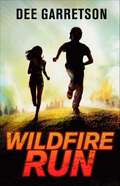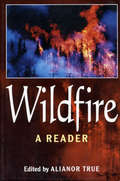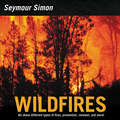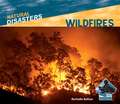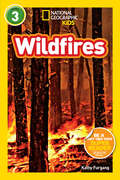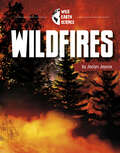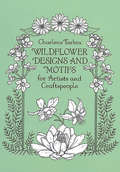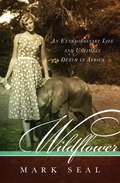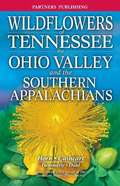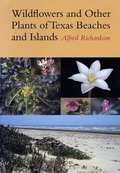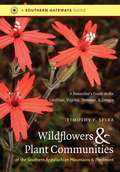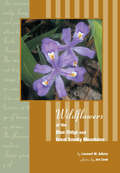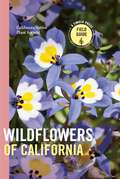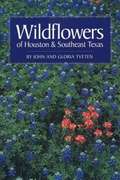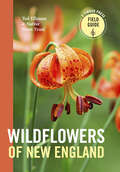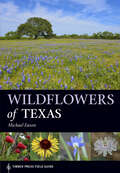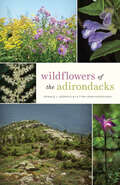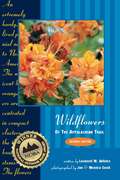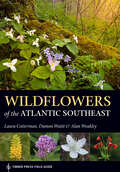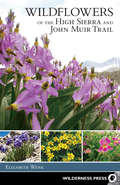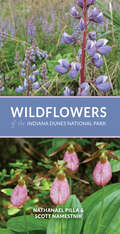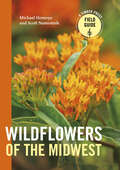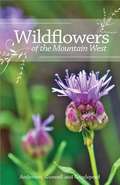- Table View
- List View
Wildfire (The Wild Series)
by Rodman PhilbrickNewbery Honor author Rodman Philbrick sends readers straight into the nightmare of a raging wildfire as 12-year-old Sam is trapped by explosive flames and deadly smoke that threaten to take his life. Can he survive?Flames race toward Sam Castine's summer camp as evacuation buses are loading, but Sam runs back to get his phone. Suddenly, a flash of heat blasts him as pine trees explode. Now a wall of fire separates Sam from his bus, and there's only one thing to do: Run for his life. Run or die.Lungs burning, Sam's only goal is to keep moving. Drought has made the forest a tinderbox, and Sam struggles to remember survival tricks he learned from his late father. Then, when he least expects it, he encounters Delphy, an older girl who is also lost. Their unlikely friendship grows as they join forces to find civilization.The pace never slows, and eventually flames surround Sam and Delphy on all sides. A powerful bond is forged that can only grow out of true hardship -- as two true friends beat all odds and outwit one of the deadliest fires ever.At the end of the novel, information about wildfires and useful safety tips add to the reader's understanding of one of the US's most dangerous natural disasters.
Wildfire Run
by Dee GarretsonThe president's retreat, Camp David, is one of the safest places in the United States. So why can't the President's son, Luke, and his friends Theo and Callie stay there without Secret Service agents constantly hovering over them, watching their every move? And yet, when an earthquake sets off a raging wildfire, causing a chain reaction that wreaks havoc at Camp David, they are suddenly on their own.Now Luke needs a plan:To override the security systemsTo save those who were supposed to save himTo get through an impassable gateTo escape Camp DavidDebut author Dee Garretson delivers a heart-pounding tween thriller—an action-packed adventure with undeniable suspense.
Wildfire: A Reader
by Alianor TrueDuring the summer of 2000, Americans from coast to coast witnessed the worst fire season in recorded history. Daily news reports brought dramatic images of vast swaths of land going up in smoke, from the mountains of Montana and Wyoming, to the scrublands of Texas, to Los Alamos, New Mexico, where a controlled burn gone awry threatened forests, homes, and even our nation's nuclear secrets. As they have for centuries, wildfires captured our attention and our imagination, reminding us of the power of the natural forces that shape our world. In Wildfire: A Reader nature writer and wildland firefighter Alianor True gathers together for the first time some of the finest stories and essays ever written about wildfire in America. From Mark Twain to Norman Maclean to Edward Abbey, writers featured here depict and record wildfires with remarkable depth and clarity. An ecological perspective is well represented through the works of John Muir, Aldo Leopold, and John McPhee. Ed Engle, Louise Wagenknecht, and Gretchen Yost, firefighters from the front lines, give us exciting first-person perspectives, reliving their on-the-ground encounters with forest fires. The works gathered in Wildfire not only explore the sensory and aesthetic aspects of fire, but also highlight how much attitudes have changed over the past 200 years. From Native Americans who used fire as a tool, to early Americans who viewed it as a frightening and destructive force, to Aldo Leopold and other conservationists whose ideas caused us to rethink the value and role of fire, this rich collection is organized around those shifts in thinking. Capturing the fury and the heat of a raging inferno, or the quiet emergence of wildflowers sprouting from ashes, the writings included in Wildfire represent a vital and compelling addition to the nature writing and natural history bookshelf.
Wildfires
by Seymour SimonA raging wildfire can be a major disaster, costing lives and destroying homes. But fires in nature can help as well as harm, clearing forests of dead trees and allowing young plants to grow. Breathtaking photos highlight this surprising look at fire’s part in maintaining the balance of nature. This nonfiction picture book is an excellent choice to share during homeschooling, in particular for children ages 6 to 8. It’s a fun way to learn to read and as a supplement for activity books for children.This updated edition includes:• Author’s note• Stunning full-color photographs• Glossary• Index• Websites and additional reading sources• Series thumbnails on back coverSupports the Common Core Learning Standards, Next Generation Science Standards, and the Science, Technology, Engineering, and Math (STEM) standards
Wildfires (Natural Disasters)
by Rochelle BaltzerThe book introduces readers to the basics of wildfires. Readers will learn why they happen, where they occur, and how they affect land. Types of wildfires are also explained, and a simple diagram illustrates the fire triangle. A Case Study chapter discusses the Peshtigo Fire of 1871, while a map aids comprehension. Firefighting and smoke jumpers, damage and cleanup work, safety methods, and preventive measures are also covered.
Wildfires (Readers)
by Kathy FurgangLearn all about wildfires—how they happen, why they're important, and when they're dangerous—in this fascinating level 3 reader. It's sure to ignite your interest, with color photographs, interesting facts, and more.
Wildfires (Wild Earth Science)
by Jaclyn JaycoxSmoke in the air. Crackling wood. Wildfire! Get to safety, fast. Dry weather, strong winds, and careless actions can all cause forests to burn. Firefighters battle wildfires from the ground and from above. But you can be prepared! Learn about wildfires and how to prevent them, pay attention to warnings, and stay safe.
Wildflower Designs and Motifs for Artists and Craftspeople (Dover Pictorial Archive)
by Charlene TarboxClear, accurate illustrations of 163 common North American wildflowers -- tiger lily and water lily, snowdrop, ox-eye daisy, thistle, and wild strawberry among them. The flowers are depicted in full-page and half-page sizes in many different configurations: as individual blossoms, in borders, corners, clusters, wreaths, and garlands. Some are shown in frames.
Wildflower Gardening
by James Underwood Crockett Oliver E. AllenThis gardening reference will teach you which wildflowers will grow best in your own backyard. Co-authored by James Underwood Crockett, an distinguished horticulturist, writer on gardening and, TV guru of plant care.
Wildflower: An Extraordinary Life and Untimely Death in Africa
by Mark SealWILDFLOWER is the gripping life story of the naturalist, filmmaker and lifelong conservationist Joan Root. From her passion for animals and her hard-fought crusade to save Kenya's beautiful Lake Naivasha, to her storybook love affair, Root's life was one of a remarkable modern-day heroine. After 20 years of spectacular, unparalleled wildlife filmmaking together, Joan and Alan Root divorced and a fascinating woman found her own voice. Renowned journalist Mark Seal has written a breathtaking portrait of a strong woman discovering herself and fighting for her beliefs before her mysterious and brutal murder in Kenya. With a cast as wild, wondrous and unpredictable as Africa itself, WILDFLOWER is a real-life adventure tale set in the world's disappearing wilderness. Rife with personal revelation, intrigue, corruption and murder, readers will remember Joan Root's extraordinary journey long after they turn the last page of this compelling book.
Wildflowers Of Tennessee, The Ohio Valley, And The Southern Appalachians
by Dennis Horn David Duhl Thomas Hemmerly Tavia Cathcart Tennessee Native Plant Society StaffThis gorgeous field guide is the most comprehensive ever published on the spectacular and breathtaking flora of this region. Specific references are made to Tennessee, but the entire Ohio River Valley and central and southern Appalachian Mountains are covered. Highlights of this all-inclusive guide include: • the flora of 16 states in one complete volume; • over 1250 species in 90 families; • 800 dazzling, full-color photographs are paired with delightful and informative text; • a helpful Color Key for finding a flower by bloom color and shape; • detailed descriptions of the plant, including the flowers, leaves, fruits, habitats and distribution; • engaging information on history, medicine, Native American traditions, folklore and the origin of names; • illustrated keys for 112 large families; • a complete glossary, with illustrated guide to flower parts. This landmark achievement is indispensable for both amateurs and experts eager to explore and appreciate the world of wildflowers in this botanically rich and unique region.
Wildflowers and Other Plants of Texas Beaches and Islands
by Alfred RichardsonMany visitors to Texas beaches see only the sands between the surf and the first low dunes. Because few plants grow there, it's easy to get the impression that Texas beaches consist mostly of barren sand-while just the opposite is true. Beyond the dunes grow an amazing variety and abundance of native plants. Many of them, like Indian Blanket, Goldenrod, and Seaside Gerardia, produce great splashes of flowering color. Others display more modest flowers or are interesting for their growing habits. In all, over seven hundred species of flowering plants grow on Texas beaches and islands. This handy field guide will aid you in identifying some 275 common and/or noteworthy flowering plants of the Texas beaches and islands from the Rio Grande to the Louisiana border. Each plant is illustrated by a color photograph, accompanied by a description of its appearance, habitat, and blooming time. The plants are grouped by families, which in turn are arranged according to relationships and similarities for easy reference. An introduction to beach habitats and plant life, references for further reading, and a glossary of terms make this book fully useful for everyone who wants a good, general understanding of beach plant life and wildflowers.
Wildflowers and Plant Communities of the Southern Appalachian Mountains and Piedmont
by Timothy P. SpiraThis richly illustrated field guide serves as an introduction to the wildflowers and plant communities of the southern Appalachians and the rolling hills of the adjoining piedmont. Rather than organizing plants, including trees, shrubs, and herbaceous plants, by flower color or family characteristics, as is done in most guidebooks, botanist Tim Spira takes a holistic, ecological approach that enables the reader to identify and learn about plants in their natural communities. This approach, says Spira, better reflects the natural world, as plants, like other organisms, don't live in isolation; they coexist and interact in myriad ways. Full-color photo keys allow the reader to rapidly preview plants found within each of the 21 major plant communities described, and the illustrated species description for each of the 340 featured plants includes fascinating information about the ecology and natural history of each plant in its larger environment. With this new format, readers can see how the mountain and piedmont landscapes form a mosaic of plant communities that harbor particular groups of plants. The volume also includes a glossary, illustrations of plant structures, and descriptions of sites to visit. Whether you're a beginning naturalist or an expert botanist, this guidebook is a useful companion on field excursions and wildflower walks, as well as a valuable reference. Southern Gateways Guide is a registered trademark of the University of North Carolina Press
Wildflowers of Blue Ridge and Great Smoky Mountains
by Leonard Adkins Joe CookUsing full-color photography and expertly crafted prose, Wildflowers of the Blue Ridge and Great Smoky Mountains turns a day hike or drive through our nation's most beautiful and rugged expanse of forested mountains into an object lesson in the stunning beauty of nature.
Wildflowers of California
by California Native Plant SocietyExperience the vibrant diversity of West Coast Wildflowers with this amazing, informative guide to more than 1,200 plant species.Wildflowers of California is a comprehensive field guide for anyone wishing to learn about the amazingly diverse wildflowers of the region. Organized by flower color and shape, and including a range map for each flower described, the guide is as user-friendly as it is informative. This must-have book is perfect for hikers, naturalists, and native plant enthusiasts. Describes and illustrates 1200 commonly encountered species Includes perennials, annuals, and shrubs, both native and nonnative Thousands of superb color photographs and range maps User-friendly organization by flower color and shape
Wildflowers of Houston and Southeast Texas
by John Gloria TvetenYou'll find them throughout the year in Houston-lyre-leaf sage, Drummond skullcap, silver-leaf nightshade, snow-on-the-prairie, lemon beebalm, scarlet pimpernel, plains wild indigo, spring ladies'-tresses, deer pea vetch. These wildflowers and hundreds of other species flourish in this part of Texas, but until this book was published in 1993 no guide had focused exclusively on the Houston area. John and Gloria Tveten spent years seeking out both the common and the rare flowers. They describe here more than 200 plants. A color photograph of each one will make identification easy. The guide is arranged by color, with each entry tracing the history and lore of a species. Many plants-for example, prairie Indian plantain and self-heal-were used by Native Americans for medicinal purposes. Others, like pokeweed and wapato, are edible. Southern dewberry and giant ragweed are used as natural dyes. And some, like rattlebush and milkweed, are poisonous. At the end of each species account is a list of key identifying characteristics for quick reference in the field. Summaries of plant families are also included, as well as tips on where and when to look for wildflowers.
Wildflowers of New England: Timber Press Field Guide (A Timber Press Field Guide)
by Ted Elliman New England Wild Flower SocietyWildflowers of New England is for hikers, naturalists, gardeners, and anyone wishing to learn more about the region’s diverse wildflowers, or just wanting to know the answer to "What’s that plant?" Ted Elliman, a plant ecologist for the New England Wild Flower Society, describes and illustrates more than 1,000 species commonly found in all six New England states, including annuals, perennials, and biennials, both native and naturalized. This helpful field guide uses a logical and convenient identification key based on flower color, petal arrangement, and leaf characteristics. One thousand color photographs help to confirm that you’ve got the right plant. The introduction includes an explanation of plant parts and information on plant names.
Wildflowers of Texas (A Timber Press Field Guide)
by Michael EasonA comprehensive field guide to the wildflowers of the Lone Star State In Wildflowers of Texas, Michael Eason describes and illustrates more than 1,100 commonly encountered species, both native and introduced. The book is organized by flower color, with helpful color coding along the page edges making it easy to navigate. Each profile is illustrated with a color photograph and includes the plant’s Latin name, family, common name, habitat, bloom time, frequency of occurrence, and a short description of the plant’s morphology. This authoritative trailside reference is a must-have for nature lovers and wildflower enthusiasts.
Wildflowers of the Adirondacks
by Lytton John Musselman Donald J. LeopoldThe definitive field guide to the magnificent wildflowers of the Adirondacks.Covering more than six million acres of protected wilderness, the Adirondacks, with their landscape of high peaks, verdant wetlands, majestic trees, and lush carpets of flowers, is a pristine paradise for nature lovers. The only available identification guide to the Adirondack region's wildflowers, this comprehensive resource is packed with more than 300 gorgeous color images, one to represent almost every flower commonly found in this huge range. Revealing the stunning diversity of Adirondack wildflowers, from goldenrod and marsh blue violet to cattails and hellebore, the book includes • detailed botanical species accounts, arranged by flower color• images of each flower that highlight key features for easy ID• information about each species' natural history• descriptions of the region's upland, wetland, and aquatic habitats• a special section on the nearly 40 terrestrial orchid species found in the AdirondacksWritten by Donald J. Leopold and Lytton John Musselman, skilled botanists and the foremost authorities on these plants, this superior quality guide will appeal to residents of and visitors to the Adirondacks and northeastern mountains, including wildlife professionals, citizen scientists, backpackers, campers, photographers, bird watchers, artists, and wild food foragers.
Wildflowers of the Appalachian Trail
by Leonard Adkins Joe Cook Monica CookWildflowers of the Appalachian Trail is the go-to resource for anyone interested in the wildflowers found along the 2,175-mile-long Appalachian National Scenic Trail. Stunning full-page color photos by Joe Cook and Monica Cook accompany the detailed descriptions by author Leonard Adkins. Also included for many of the 94 flowers profiled in the book is the fascinating role the flower has played through history and its value in folkloric as well as modern medicine.
Wildflowers of the Atlantic Southeast (A Timber Press Field Guide)
by Laura Cotterman Damon Waitt Alan WeakleyFinding wildflowers in the Southeast has never been easier!Wildflowers of the Atlantic Southeast is an authoritative trail-side reference for hikers, naturalists, gardeners, and anyone wishing to learn more about the region’s diverse flora. This comprehensive guide describes and illustrates more than 1,200 species, including perennials and annuals, both native and naturalized non-native. More than 1,300 superb color photographs, 1,200 range maps, and a user-friendly organization by color and other observable traits make identification easy. This must-have field guide covers Georgia, South Carolina, North Carolina, West Virginia, Virginia, the District of Columbia, Maryland, Delaware, New Jersey, and southeastern Pennsylvania.
Wildflowers of the High Sierra and John Muir Trail
by Elizabeth WenkPhotos and descriptions of 300 species of wildflowers and flowering shrubs, growing above 8000 feet in the High Sierra (Yosemite through the Whitney Region). Descriptions provide basic botanical information, written for the general public. Also includes natural history stories to make individual plants come alive and be easier to remember.
Wildflowers of the Indiana Dunes National Park
by Nathanael Pilla Scott NamestnikIndiana Dunes, located on the picturesque coast of Lake Michigan, is one of the most biologically diverse parks in the US national park system. Keen hikers can spot white mayapple blooms, orange-fringed orchids, pink lady slippers, and more.Wildflowers of the Indiana Dunes National Park offers visitors a unique handbook highlighting over 160 of the common and exceptional wildflowers found along the trails of Indiana Dunes National Park and the surrounding area. This accessible field guide bypasses the dry nature of many wildflower guides. In addition to the usual scientific species names, descriptions, and bloom periods, Nathanael Pilla and Scott Namestnik offer deeper narratives—folklore surrounding the flowers, look-alikes, animals associated with the plants—that will be remembered much more easily than the length of a petal.Illustrated with over 350 color photographs, Wildflowers of the Indiana Dunes National Park will be an asset to the casual hiker of Indiana Dunes National Park, a useful tool to the experienced botanist, and a delight to anyone interested in wildflowers.
Wildflowers of the Midwest (A Timber Press Field Guide)
by Scott Namestnik Michael HomoyaIdeal for hikers, foragers, and plant lovers, the Timber Press Field Guides are the perfect tools for loving where you live. Wildflowers of the Midwest is a comprehensive field guide for anyone wishing to learn about the amazingly diverse wildflowers of the region. This must-have book describes and illustrates 1000 commonly encountered species, including perennials, annuals, and shrubs, both native and nonnative. With more than 1,000 superb color photographs and a user-friendly organization by flower color and shape, this is a must-have guide for birders, hikers, foragers, and natural history buffs. Covers Minnesota, Wisconsin, Michigan, Ohio, Indiana, Illinois, Missouri, and Iowa. Describes and illustrates 1,000 commonly encountered species Includes perennials, annuals, and shrubs, both native and nonnative User-friendly organization by flower color and shape
Wildflowers of the Mountain West
by Richard M. Anderson Jerry L. Goodspeed Jay Dee GunnellMany recreational hikers have stopped along the trail to admire a wildflower only to wonder what, exactly, they are looking at. Wildflowers of the Mountain West is a useful field guide that makes flower identification easy for the general outdoor enthusiast.Many available plant guides are too technical or cumbersome for non-specialists to embrace. Covering New Mexico, Colorado, Wyoming, Idaho, Utah, Nevada and Oregon, this book is perfect for the enthusiasts who has little botanical knowledge but would like to know more about the wildflowers they are seeing. Organized by flower color for easy reference, plant records include the common and scientific names, a description of typical characteristics, habitat information and distribution maps, look-alike species, color photographs, and informative commentary. In addition, the book provides a useful introduction to the Mountain West region, along with line drawings to illustrate basic flower parts, shapes, and arrangements; a glossary of common botanical terms; a quick search key; and an index.The book is spiral-bound, making it easy to bring along while hiking, backpacking, or biking, and stunning full color photographs make visual confirmation of flower type simple and straightforward.
